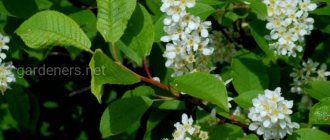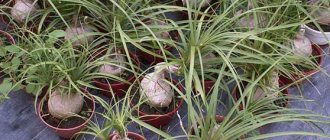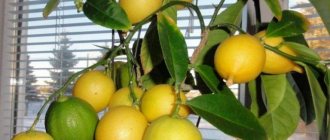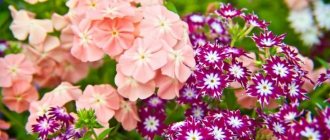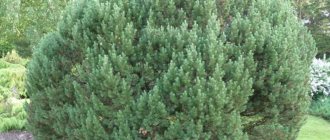Thuja is a fairly strong coniferous tree, undemanding to growing conditions, grows quickly, and is frost-resistant. It is native to North America, where it is called Arbor vitae, which means tree of life in Latin.
We grow an evergreen “living” hedge from thuja
This name was given to it for its evergreen foliage, a feature that has made it one of the conifers most commonly used for hedges.
Thuja hedge
Thuja is resistant to diseases and fungi, however, sometimes suffers from various diseases, such as: wilt of thuja, late blight, thuja false scale, schutte and rust, fusarium, or even attacks by insect pests such as weevils, thuja aphids, spider webs mite. All these diseases are often the result of poor crop conditions for thuja: heavy and wet soil, lack of water during drought (stress for the plant) or single planting of a hedge.
Late blight
Phytophthora thuja. Illustrations taken from open sources.
Symptoms
First we see spots of rotting on the neck and roots. The lower part of the trunk becomes soft. After this, the foliage will turn brown locally, then throughout the branch, and then throughout the entire tree. It is considered one of the most famous and dangerous diseases. The cause may be poorly drained soil, as water stagnates. Another reason is when arborvitae are under stress, such as under drought conditions, or if they are grown in heavy clay soils. For prevention purposes, heavy clay soils, excess nitrogen and too dense planting should be avoided, and thuja should be periodically watered with fungicides.
Sick thujas
Healing: The only effective treatment is to remove the affected tree, and when replacing with another tree, it is also necessary to provide for changing the soil at the planting site.
Moth
Small larvae (4 millimeters in size) of this moth gnaw tree branches. As a result, they turn brown and the shoots die.
The moth moth loves spruce plants, and thuja is no exception.
Treatment
If you see traces of such larvae on your tree, you can prevent their further destructive effect by simply pruning. Treating thuja at the end of June with products (twice with an interval of eight days) that contain pyrethroids will also help stop moths. For example, Fumitox Anti-mite, Tornado Anti-mite, Moskitol Anti-mite.
Thuja false scale
False scale insect on thuja.
Illustrations taken from open sources. With this disease, the bark of the tree becomes covered with yellow ulcers, which gradually increase in size and, if the spots cover the entire trunk, the tree will die. To prevent this from happening, treatment with karbofos, actellik or any other fungicide should be started immediately. You can try folk remedies, for example, wrap the trunk in burlap and treat the branches with a solution (mix 20 grams of laundry soap with 1 liter of water and add 10 mm of alcohol).
Spider mite
This pest is especially dangerous for trees that grow in dry soil. By the end of summer, the amount of damage increases, since the tick can produce about six generations during this period.
Spider mites entwine branches so that they cannot receive moisture and sunlight
You can recognize it by the fact that the thuja needles become entangled in cobwebs and become covered with yellow spots, eventually falling off.
How to fight?
At the first appearance of spider mites on your thuja, spray it with infusions of dandelion, garlic or colloidal sulfur. In case of large damage, acaricides will help. To prevent the disease, you can spray the tree with cold water. This will increase humidity and repel ticks.
Schutte and rust
Affected thuja branches.
These fungal diseases are characteristic of all coniferous plants, especially young ones. The needles become dark in color and then fall off. The disease can appear at any time of the year. To prevent the disease from spreading to other coniferous plantations, all affected branches should be pruned and burned, and the trees should be treated with Hom (40 g per 10 l of water), or Topsin-M (15 g per 10 l of water), treatment should be carried out in early spring and in the middle summer.
On a note! For preventive purposes, all coniferous trees are sprayed, but only in the spring. You can also use Bordeaux mixture.
Preventing diseases with proper care
The fight against thuja diseases is of course possible, but it is best to prevent this. Although thuja is not a fastidious plant, it needs to be looked after, namely regularly watered, fed, pruned and weeded. Most diseases occur due to excessive humidity, so excessive watering is dangerous for thuja. It is enough to water once every 6-7 days.
It is not recommended to fertilize thuja with some organic matter, namely manure and chicken droppings. These substances contain many microorganisms that can cause thuja to get sick. It is recommended to regularly remove weeds, which also sometimes cause infectious diseases and attract pests. For the treatment of thuja diseases, fungicides and Bordeaux mixture are effective drugs. Insects are killed using traditional methods and insecticidal preparations. Heavily damaged parts of the plant need to be pruned and destroyed. The main thing is to monitor the signs of the disease in time and start fighting it!
Insects
In addition to diseases, thujas can be attacked by insect pests, including aphids, spider mites, and thuja weevils.
In addition to chemicals (Fufanon), you can use folk remedies for spider mites and aphids.
Spray treatment with garlic infusion.
Soak for 24 hours 100 g of fresh garlic in 5 parts. l. vegetable oil. Strain it all and add it to a liter of water with 1 tbsp. l. laundry soap. Spray the mixture once a week on the attacked thujas.
Mixture with laundry soap
You can choose a mixture of a teaspoon of laundry soap, a teaspoon of vegetable oil and a teaspoon of 70° alcohol. Pour all this into a liter of water and spray on the thuja.
Gray larch leaf roller
These dark caterpillars wrap thuja needles in a web, making cocoons. Pests are located in the middle of the cocoons. This causes the thuja to lose its decorative appearance and may die over time.
Remedies for leaf roller
To prevent the appearance of the caterpillar, you need to spray with one of these drugs: Fufanon, Decis Profi, Actellik. The rate of the latter drug is 15-20 ml/10 l of liquid. The consumption of the working solution is 1 l/10 m². Spraying with Actellik is carried out in May - early June, repeated spraying in the summer when the pest population is large.
How to avoid thuja diseases?
Growing Healthy Arborvitae
To avoid all sorts of diseases and pest attacks, you must make sure that your trees grow in the best conditions. A plant suffering from stress or deficiency will be more susceptible to insect attack or disease. In addition, it will produce stress phytohormones that will attract insect pests.
Thujas are resilient, but are afraid of heavy and always wet soils. So consider providing it with well-drained, moist soil when planting.
If, on the other hand, the soil is too filtery, you should consider ensuring that the plant does not suffer from a lack of moisture during the dry season.
On a note! The plant should be watered once a week or a month, depending on the condition of the soil and weather conditions.
Young thujas need more frequent watering. In the summer heat, to avoid moisture loss, you need to mulch with peat.
Methods for resuscitation of conifers after winter
Very often, with insufficient care of thujas after winter, yellowing of the needles and dying of branches are observed. Often gardeners simply throw away the plant. However, in most cases the tree can be restored . For this, the methods familiar to everyone are used - fertilizing, mulching, pruning affected branches.
Plant nutrition
Immediately after wintering, the soil around the affected plant must be loosened well . Next, a solution of mullein is added, which is purchased ready-made and applied according to the instructions. If the infusion is made independently, then take 1 part of dry raw materials to 9 parts of water. Thus, for a standard 10-liter bucket you can take from 0.5 to 1 liter of solution.
The water must be warm (it should be comfortable for your hands). Water 4-5 liters for each young tree and 2 times more for older thujas.
Mulching
This is a reliable, proven method that is applied immediately after fertilization. The composition of the mulch is arbitrary, but it is better if it contains pine litter:
- dry needles;
- crushed bark;
- foliage;
- peat, crushed into crumbs.
The ratio of components is approximately the same, and you can take 2 times more needles. Mulch is traditionally laid around the trunk at a distance of 30-40 cm.
Pruning branches
A mandatory measure for plant resuscitation is pruning branches that have dried out, cracked and turned yellow - i.e. have obvious signs of dying. The procedure is done with ordinary or well-sharpened garden shears, which are pre-disinfected in boiling water or any antiseptic.
Use of drugs
And the most effective measure for resuscitating thuja is the use of special preparations that help restore growth and also protect the tree from sunburn and moisture loss. The choice of means is quite wide, but there are few that have proven themselves among summer residents. One of these drugs is the drug "Purshat-O" , which you can learn more about in the next section.
NOTE
If the thuja was wrapped in linen burlap for the winter, you should not release it immediately. You need to wait until the temperature outside is positive (daily), and in the first 2 weeks create slight shading - otherwise spring rays can burn the needles.
General information about conifers
Any variety of conifers can grow in the country.
This culture is especially widespread in regions with cool climates, but southern residents are gradually joining the ranks of adherents of needle decoration. Despite their endurance to external negative factors, conifers can have different adaptations to environmental conditions. In an environment unusual for them, coniferous trees find it difficult to take root, wither and lose resistance to various infectious diseases. Therefore, in the first 5-6 years after planting, it is necessary to provide them with adequate care. If the tree looks unhealthy despite all the steps taken, it is important to find the root cause. These can be pathologies of an infectious or non-infectious nature.
Click beetles
These root pests look like thirteen millimeter black or brown beetles. At first they feed on thin roots and humus. When the larvae grow up, they begin to feed on thick roots. As a result, the tree weakens, its development stops, the needles dry out and fall off. This pest is especially common in low areas where there is moisture.
Click beetles are dangerous pests of thuja. They eat the roots
Removing the beetle
Drainage, soil deoxidation, and digging up the soil in the fall help prevent the spread of click beetles. You can also add diazonin preparations to the soil. For example, “Trap”, “Bazudin”, “Zemlin”.
Using iron sulfate: safety precautions
Iron sulfate is less dangerous to the human body than copper sulfate. Officially, it belongs to class 3 toxic substances, which is not explosive or flammable. When working with iron sulfate, you do not need to use special protection; it is important that the solution does not get on the mucous membranes of the mouth and eyes.
If ferrous sulfate solution comes into contact with your skin, wash it with soap and water. Fertilizers must be stored in the chemical category, away from tableware and food. It is better to use the solution in the fall than in the spring. At this time, the trees are already bare, the leaves have fallen and they are not in danger of being burned by iron sulfate. The use of iron sulfate before wintering allows for disinfection.
The following rules must be observed so that the fertilizer does not cause harm:
- You should always carefully read the instructions on the package; do not exceed the proportions.
- Vitriol should be diluted in plastic, enamel or glass containers.
- It is necessary to protect your hands with rubber gloves when processing.
- Iron sulfate must not be mixed with lime! Lime is combined only with copper sulfate.
- Crystalline ferrous sulfate can be stored indefinitely, keeping it away from moisture.
-Music
–Categories
- AGROTECHNIQUES OF NATURAL FARMING (215)
- ALTERNATIVE TO GARDEN (260)
- Balconies and more (121)
- Home pond (25)
- Winter garden (29)
- Miniature gardens (97)
- DISEASE CONTROL (343)
- PEST CONTROL (579)
- FIGHTING GNUS (39)
- WEED CONTROL (81)
- IN THE FOREST, HIKE, FISHING, IN EXTREME SITUATION (89)
- VIDEO ABOUT THE GARDEN (538)
- WATER OBJECTS (196)
- =GENERAL TIPS= (32)
- Reservoirs (163)
- Imitation of a pond, dry stream (15)
- LAWN (55)
- COOKING AT THE COUNTRY (1623)
- Everything in a row (26)
- Desserts (139)
- Brazier, barbecue, grill, fire (187)
- Drinks (105)
- Pancakes, pancakes, pies, etc. (454)
- Main courses (631)
- First courses (108)
- Salads, snacks (199)
- Spirits (20)
- Storing food without refrigeration (10)
- MUSHROOMS AT THE COUNTRY (24)
- COUNTRY PHARMACY (0)
- COUNTRY HOUSE (771)
- Country house decor (185)
- MARINE STYLE (MEDITERRANEAN) (114)
- Interior (223)
- Furniture (163)
- Cute, cozy things (92)
- Original houses (103)
- Utilities (38)
- DECORATIVE SHRUBS (305)
- TREES (23)
- FOR CHILDREN IN THE GARDEN (166)
- PATHWAYS, SITES (136)
- LIVING GARDEN ASSISTANTS (127)
- PREPARATIONS FOR WINTER (1506)
- Jams, jams: OTHER (124)
- Preserves, jams: FRUIT (124)
- Preserves, jams: BERRIES (123)
- Wines, liqueurs, tinctures (162)
- Freezing – VEGETABLES (46)
- Freezing – FRUITS, BERRIES (18)
- Ketchups, sauces (61)
- Compotes, etc. (40)
- Vegetable caviar (43)
- Semi-fabricated products (129)
- Benefits for canning (31)
- Salads (318)
- Pickles: ASSORTED (26)
- Pickles: EGGPLANT (55)
- Pickles: PEAS, BEANS, CORN (32)
- Pickles: MUSHROOMS (37)
- Pickles: Zucchini, Squash, Watermelon (62)
- Pickles: CABBAGE (24)
- Pickles: CUCUMBERS (63)
- Pickles: PEPPERS (89)
- Pickles: TOMATOES (140)
- Pickles: CAULIFLOWER (9)
- Pickles: GARLIC, RADISH (14)
- Drying (94)
- Horseradish and savory snacks (25)
- HEALTH IN THE GARDEN (89)
- RECREATION AREAS (139)
- .DIFFERENT IDEAS (78)
- Hammocks, sun loungers (46)
- Privacy zone (14)
- Patio (21)
- COUNTRY DECOR IDEAS (730)
- INVENTORY (44)
- Other tools (30)
- Small mechanization in the garden (9)
- Fokina flat cutter (10)
- INTERESTING PLANTS OF THE WORLD (155)
- ROCKY SLIDE (101)
- =GENERAL TIPS= (62)
- Rock garden (58)
- PICTURES (5)
- COMPOST, FERTILIZERS (460)
- CURIOUS ! (51)
- LANDSCAPE DESIGN (284)
- MEDICINAL PLANTS AT THE COUNTRY (406)
- SMALL GARDEN (93)
- SMALL ARCHITECTURAL FORMS (280)
- Gazebos, pavilions, rotundas (54)
- Flowerpots (11)
- Fence, fencing, border (39)
- Swings (16)
- Wells (7)
- Stairs, retaining walls (17)
- Summer kitchens, barbecues, grills (10)
- Bridges (8)
- Pergolas, arches, trellises, trellises (35)
- Benches, benches (58)
- Garden sculpture (24)
- Lanterns, columns (10)
- MUSIC (33)
- VEGETABLE GARDEN (2333)
- .Other plants. (130)
- =BEDS= (84)
- =ORNATIVE VEGETABLE GARDEN= (82)
- =GENERAL TIPS= (280)
- =SOWING, SEEDLING, PLANTING OF VEGETABLE CROPS= (384)
- Watermelons, melons (27)
- Eggplant (48)
- Zucchini, squash, zucchini (38)
- Cabbage (114)
- Potatoes (186)
- Onions, garlic (236)
- Carrots (82)
- Unusual beds (7)
- Cucumbers (284)
- Peppers (98)
- Radish, turnip, radish (44)
- Beetroot (37)
- Salads, asparagus (6)
- Tomatoes (414)
- GARDEN ON THE WINDOW SILL (150)
- USEFULNESS (77)
- Devices (49)
- Conspiracies (13)
- Computer devices (6)
- GREENHOUSES, GREENHOUSES (100)
- SITE PLANNING (85)
- FRUIT TREES, SHRUBS, BERRIES (1151)
- =TRIMING, WHITESHING, CARE, FORMATION= (142)
- =FEEDING= (13)
- =LANDING, STRUGGLE= (97)
- =VACCINATIONS= (42)
- Quince (7)
- Actinidia (16)
- Grapes (74)
- Cherry, sweet cherry (38)
- Pear (22)
- Honeysuckle (25)
- Strawberries, strawberries (310)
- Irga (12)
- Cranberries, blueberries, lingonberries, etc. (24)
- Gooseberry (58)
- Schisandra (9)
- Raspberries, blackberries (154)
- Sea buckthorn (25)
- Peach (12)
- Rowan, chokeberry (4)
- Plum, sloe (24)
- Currant (125)
- Apple tree (97)
- WATERING (113)
- LANDING (2)
- SOIL, MULCH (129)
- HOLIDAY AT THE DACHA (170)
- Children's party (6)
- New Year (111)
- Easter (6)
- Picnic (31)
- Family holiday (28)
- SPICE BEDS (133)
- VARIOUS TIPS (391)
- DIFFERENT IDEAS (168)
- S A M O D E L K I (430)
- LINKS (70)
- GARDEN PLANTS (28)
- GARDENS, PARKS, FLOWER BEDS OF THE WORLD (455)
- SEASONS IN THE GARDEN (489)
- =LUNAR CALENDAR= (22)
- Spring (111)
- Winter (37)
- Summer (54)
- Folk signs (28)
- Autumn (263)
- ANIMAL)))))) YARD (91)
- SAVE THE HARVEST (102)
- GARDEN STYLES (105)
- CONSTRUCTION AT THE COUNTRY (702)
- Bath, sauna, shower, bathhouse, washbasin (95)
- Water on site (43)
- House (208)
- Fence, fencing, border (86)
- Well (11)
- Roof (12)
- Summer kitchens, barbecues, grills (85)
- Outbuildings (49)
- Garden lighting (36)
- Stoves, fireplaces (96)
- Repair (32)
- Toilet (33)
- TOPIAR ART (10)
- SELF-CARE AT THE COUNTRY (50)
- Beauty from the garden (38)
- LET'S LEARN FROM EACH OTHER! (107)
- F O T O (54)
- FLORISTRY (185)
- HVOYNIKI (97)
- FLOWER BEDS (720)
- =GENERAL TIPS= (83)
- Vertical gardening (127)
- Ideas for original flower beds (433)
- Mobile flower beds (85)
- Flower garden near the house (front garden) (38)
- Continuous flowering beds (25)
- Flower beds with conifers (13)
- Flower beds shade and partial shade (38)
- FLOWERS IN THE HOUSE (363)
- FLOWERS, CARE, ETC. (1583)
- .Trendy plants, vines. (99)
- .Perennials. (696)
- .Annuals. (205)
- .Primroses and bulbous plants (161)
- .Ground cover. (77)
- =DIFFERENT FLOWERS= (105)
- Alyssum (1)
- Amaranth (1)
- Pansies (3)
- Astilbe (8)
- Begonia tuberous (3)
- Whiteflower (1)
- Dahlias (18)
- Gladioli (26)
- Delphiniums (10)
- Doronicum (1)
- Calendula (1)
- Clematis (49)
- Cosmea (1)
- Cinquefoil (3)
- Daylily (13)
- Buttercups (2)
- Young (1)
- Montbrezia (4)
- Nasturtium (12)
- Sedums (4)
- Petunias (38)
- Peonies (24)
- Sunflowers (1)
- Primrose (6)
- Roses (179)
- Rudbeckia (2)
- Siberian irises (1)
- Tulips (34)
- Hosts (21)
- Chrysanthemums (13)
- Echinacea (3)
- Yasnotka (1)

